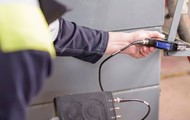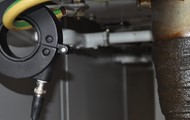Cable Line Resonance Analysis (LIRA)
Line Impedance Resonance Analysis (LIRA)
Non-Destructive Testing of cables that do not require cables to be energized to high voltages. Safer than alternative methods in ‘high risk’ environments.
Line Impedance Resonance Analysis (LIRA) was developed in 2004 for Non-Destructive Testing of cables in the nuclear industry. LIRA can be carried out on electrical cables hundreds of kilometers in length and is becoming increasingly effective for condition monitoring, or fault location, in long length cables (for example submarine cables connecting off-shore platforms to the grid).
LIRA can test for and detect numerous types of faults and defects in insulation including temperature and radiation damage, moisture ingress and mechanical impact to name a few.
LIRA relies on the correlation between insulation’s condition and its dielectric constant (mainly capacitance) and calculates the impedance spectrum (amplitude and phase) as a function of the applied signal over a wide frequency band.
The capacitance of a cable changes as a function of changes in the cables permittivity and changes in the cable’s radius, as shown below:

R = series resistance
L = series inductance
G = parallel conductance
C = parallel capacitance
Changes in the permittivity and radius of the cable change the localized impedance. Impedance irregularities cause reflections, with the largest irregularity being at the end of the cable. By analyzing standing wave patterns on short and open circuits, LIRA allows the easy detection of changes in impedance.
LIRA Features and Benefits
- LIRA is capable of being used on cables that are hundreds of kilometers in length, unlike other test methods such as VLF that are often restricted to cables of perhaps 10km
- Suitable for cable testing where energizing to working voltage is of concern
- Can be used to provide initial cable ‘fingerprinting’, so you can easily recognize when a fault has occurred on a cable. This approach provides the best results
- Accurate detection of changes in impedance
- Localizing of faults to within 0.3% of the cable length
- Can locate joints on circuits where they would be otherwise unknown
- LIRA can detect the following phenomena:
- Global insulation degradation
- High Temperature damage
- Moisture ingress
- Radiation damage
- Mechanical effects/defects
*Note: For the highest sensitivity, testing from both ends of a cable is recommended to overcome some signal loss across multiple impedance changes, although this is not a necessity.
Operation of the LIRA Instrument
A manually selected ‘sweep’, comprising 10,000 equally spaced frequencies of typically between 0Hz and 250kHz/500kHz/1MHz/2MHz/5MHz, is applied to the cable over a two-minute period. The selected frequency range must be a compromise, as lower frequencies have a lower accuracy, but higher frequencies suffer from more attenuation.
The amplitude of the applied signal is less than 10V and therefore the instrument can be connected to the circuit under test with ease and without the need for stress control. This allows direct connection at the spouts if a withdrawable circuit breaker has been removed or connection via crocodile clips onto test bushings. Motors, transformers and other loads may remain connected during testing provided that they cause a change in impedance of sufficient magnitude to reflect the applied signal at the cable’s end.
LIRA is capable of being used on cables that are hundreds of kilometers in length and is thus suited to applications that other tests which involve energizing the circuit to working voltage are not. For the highest sensitivity, double-ended testing is recommended to overcome some signal loss across multiple impedance changes, although this is not a necessity.
It is considered best practice that an initial ‘fingerprint’ of a cable is taken before any faults are known to have occurred on a cable, such as during commissioning. This then allows the most accurate detection of changes in impedance should any issues arise, and therefore the highest likelihood of localizing the fault.
Preparation for LIRA Testing
Measurements cannot be undertaken with cables in parallel as the magnitude of the signal, hence response, from each core would not be repeatable or reliable due to the multiple reflections and the inability to equally split the signal. Consequently, cables need to be tested in a single core arrangement, such that the magnitude and response of the test signal is specific to that core and cannot be diluted by external influences.
If cables are tested in series, the orientation and core references would need to be accurately detailed as that would need to be replicated on each occasion.
The most reliable and reproducible solution would be to test each phase as an individual cable, therefore necessary to disconnect and isolate both ends prior to testing.
Additional Reading about LIRA Testing: Click to download REGULATORY GUIDE 1.218
U.S. Nuclear Regulatory Commission REGULATORY GUIDE 1.218 based on draft guide DG-1240. This guide describes methods and techniques that the staff of the NRC considers acceptable for us in implementing the regulatory requirements in 10 CFR 50 with regard to monitoring the performance of electric cables used in nuclear power plants. Section 11 discusses LIRA.
Click to download REGULATORY GUIDE 1.218

Talk to an Expert
Thank you for your interest in EA Technology. You can request information or a free callback by clicking the link below. One of our experts will be in touch with you shortly.
Related Services

Online Cable condition assesment (CDC)
Online Cable Testing System Identifies and reports Partial Discharge (PD) activity in LIVE CABLES of distribution voltage.

Astute® Cable Monitoring Service
Failure of your high-voltage cable could cost millions in repairs, replacements and fines.
